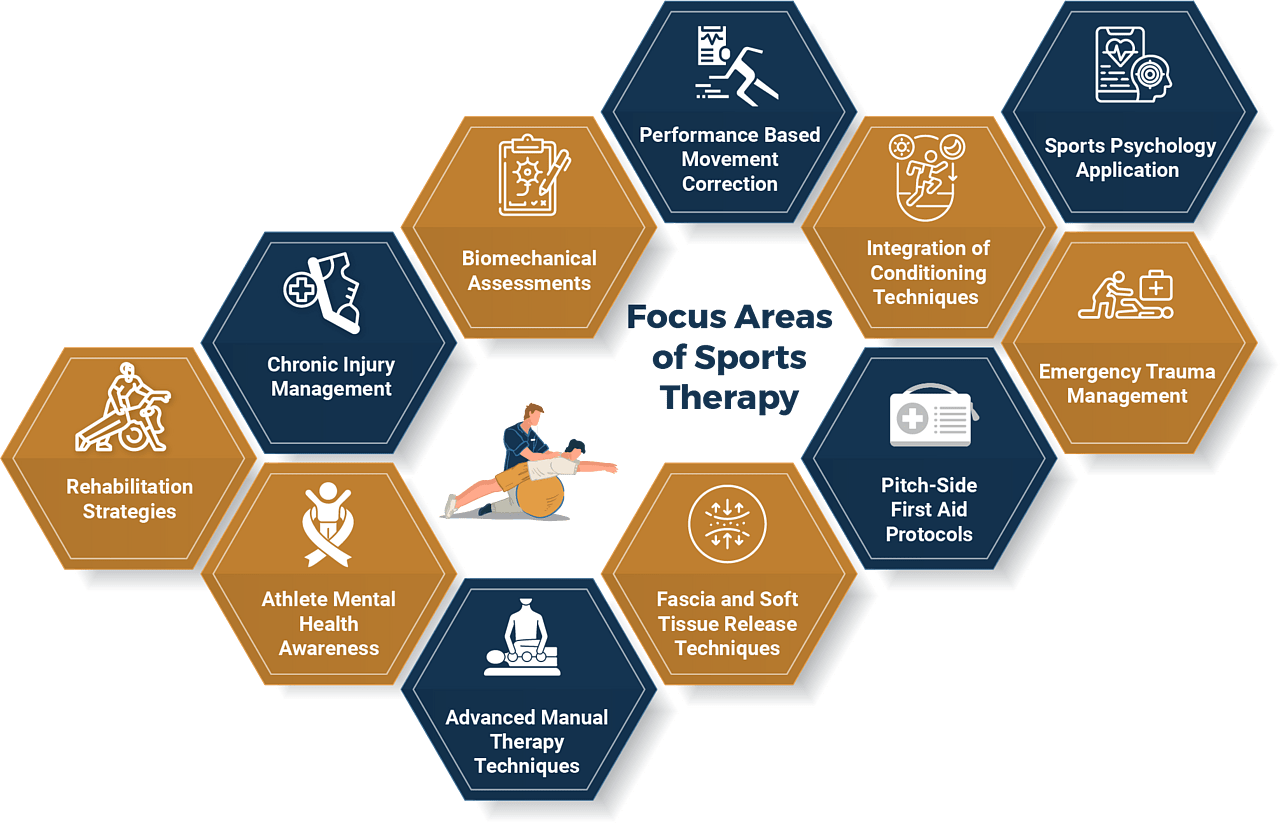Sports is a high-performance arena where fractions of a second define victory and a single misstep can sideline a career. In this context, sports have evolved over time, and sports therapy has progressed from a supportive function to a critical strategic discipline. Shaped by motion data, clinical outcomes, and performance timelines, the field demands more than intuition — it requires informed, evidence-based care. From players, elite athletes to everyday clients recovering from injury, expectations have never been higher. That’s where Continuing Professional Development (CPD) comes in — not as a formality, but as a foundation for excellence.
Key Takeaways
- Professional Development in sports therapy is essential for staying clinically current, enhancing decision-making, and aligning practice with the latest performance-driven standards.
- Professional development supports injury prevention, rehabilitation, and athlete care by integrating biomechanics, mental health, conditioning, and emergency response training into everyday practice.
- Future CPD trends focus on immersive technology, AI-guided learning, cross-disciplinary collaboration, and evidence translation to sharpen real-time decision-making in high-pressure environments.
Continuing Professional Development (CPD) in sports therapy functions as more than a compliance measure. It reflects a therapist’s ability to remain clinically informed, technically capable, and professionally accountable. In a field where every decision can influence recovery timelines, injury risk, and long-term performance, CPD underpins the judgement that matters most.
What makes CPD in sports therapy distinct is its responsiveness to the unique demands of athletic care, shaped by sport-specific data, practical field experience, and emerging research in movement science. These include performance-focused rehabilitation, biomechanics, pitch-side emergency care, and evidence-based manual therapy.
Let’s dive deeper into the evolving role of sports therapists — exploring how Continuing Professional Development (CPD) shapes their careers, the core competencies they must possess, and the emerging trends redefining the field.
Who is a Sports Therapist?
A sports therapist is a qualified healthcare professional who specialises in the prevention, diagnosis, treatment, and rehabilitation of musculoskeletal injuries, particularly those related to physical activity, exercise, and sport. They combine clinical knowledge with practical skills to support recovery, enhance performance, and minimise injury risks.
Key Roles of a Sports Therapist
- Injury Prevention: Designing targeted training and conditioning programmes to reduce the risk of injury.
- Assessment & Diagnosis: Identifying the cause and nature of physical dysfunctions or injuries.
- Treatment & Rehabilitation: Providing hands-on therapy and guided recovery plans to help individuals return to full function.
- Performance Enhancement: Supporting athletes and active individuals to optimise movement, strength, flexibility, and resilience.
- Immediate Care: Offering pitch-side or event-based first aid and trauma management.
Who Do Sports Therapists Work With?
Regulatory Requirements for Sports Therapists in the UK
In the UK, professional registration in sports therapy requires more than academic qualifications—it demands a commitment to ongoing learning and evidence of structured development. Regulatory and professional bodies such as The Society of Sports Therapists (SST) and the British Association of Sport Rehabilitators (BASRaT) mandate active engagement with Continuing Professional Development (CPD) as part of their membership standards.
These requirements are not optional—they serve as safeguards for public safety, practitioner credibility, and industry-wide accountability.
Failing to meet CPD obligations can have serious consequences. Therapists who do not maintain their CPD portfolio risk:
- Losing professional membership,
- Being ineligible for professional indemnity insurance, and
- Facing legal or ethical scrutiny during complaints or investigations.
By maintaining regulatory requirements, professionals demonstrate their fitness to practise, reinforce public trust, and stay aligned with the evolving expectations of high-performance sport and rehabilitation.
Importance of CPD in Modern Sports Therapy
CPD plays an important role in modern sports therapy. Sport therapists are expected to respond with precision, work efficiently under pressure, and justify every clinical decision with confidence. Athlete recovery and mobility outcomes are direct reflections of the therapist’s competence, placing a high level of accountability on their practice.
Continuing Professional Development (CPD) supports therapists in meeting these demands. It bridges clinical practice with current evidence, enabling professionals to adapt their methods based on emerging insights rather than outdated routines. From rehabilitation protocols to return-to-play decisions, CPD ensures that sports therapists stay aligned with the latest standards, techniques, and expectations in elite performance and athlete care.
How CPD helps Develop Key Competencies in the Focus Areas of Sports Therapy
Continuing Professional Development (CPD) plays a pivotal role in equipping sports therapists with the essential skills required to operate confidently in a fast-evolving, performance-led industry. By engaging with structured, targeted CPD, therapists continuously refine their practice and develop advanced clinical and non-clinical competencies aligned with modern athletic demands.
Below are the key areas where CPD enhances professional competence in sports therapy:

Rehabilitation Strategies
Professional development equips therapists with the skills to treat acute injuries effectively, based on current clinical evidence. Injuries like sprains, bruises, and dislocations are best treated with proper care and knowledge to support a smooth recovery. CPD also updates therapists on post-surgical protocols, bridging the gap between medical discharge and functional reintegration into physical activity.
Chronic Injury Management
Athletes often experience repeated strain on their bodies, which can lead to multiple minor injuries over time. CPD helps therapists manage tendinopathies, stress injuries, and instability with progressive strategies that go beyond symptom relief. It supports long-term performance through progressive interventions informed by current biomechanical and physiological research.
Biomechanical Assessments
Effective rehabilitation begins with understanding how the body moves and where imbalances exist. CPD helps therapists improve their ability to assess gait, load distribution, and functional asymmetries using tools like motion capture systems, pressure mapping plates, and wearable sensor technology. Skills to use such tools effectively allow therapists to diagnose and treat with precision. It also ensures therapists use updated observation techniques.
Performance-Based Movement Correction
Movement inefficiencies often contribute to injury and poor performance. Identifying areas of dysfunction is the first empowering step toward healing and improved performance. CPD offers updated strategies such as proprioceptive drills, strength sequencing, and neuromuscular re-education for movement correction aimed at restoring balance, reducing compensation, and fine-tuning movement patterns to reduce injury risk.
Integration of Conditioning Techniques
Therapists increasingly work alongside strength and conditioning coaches. CPD supports this collaboration by developing skills related to agility, plyometrics, energy systems, and load management, supporting injury prevention during reconditioning.
Sports Psychology Application
Psychological barriers can slow physical recovery, but CPD equips therapists with skills to use tools like visualisation, goal-setting, and emotional regulation to enhance consistency and progress. Resilience is intentionally built, and players are motivated, especially during long rehabilitation periods or high-stakes competition seasons.
Athlete Mental Health Awareness
Therapists are often the first to see athletes in raw, vulnerable moments and notice signs of burnout, anxiety, or emotional strain. CPD helps build awareness and appropriate response strategies, promoting ethical care and mental wellbeing while maintaining professional boundaries.
Advanced Manual Therapy Techniques
From joint articulation to dry needling and IASTM (Instrument Assisted Soft Tissue Mobilisation), CPD introduces therapists to advanced techniques, ensuring safe, effective practice grounded in updated knowledge and often regulated competencies.
Fascia and Soft Tissue Release Techniques
Continuing professional development now encompasses techniques such as myofascial release, trigger point therapy, and tissue gliding. These hands-on skills may be subtle, but they are powerful when guided by expert touch and strong anatomical knowledge.
Pitch-Side First Aid Protocols
Sports therapists must stay calm and act quickly during emergencies. CPD in pitch-side care teaches vital skills like CPR, using an AED, and spinal immobilisation. These quick, precise actions help protect athletes in high-pressure situations. In organised sport, such skills are essential.
Emergency Trauma Management
Some injuries call for swift, well-informed action. Conditions like concussion, open fractures, and dislocations can have lasting consequences if mishandled. CPD empowers therapists to assess, stabilise, and refer with confidence, while staying up to date with evolving trauma protocols specific to sport.
What Will be the CPD Trends in Sports Therapy?
Sports therapy continues to evolve, and CPD is adapting to meet the changing demands of performance-driven healthcare. The future of CPD is increasingly personalised, immersive, data-informed, and collaborative—designed to equip therapists with skills that are not just clinically relevant, but strategically forward-looking.
Below are several current innovations that are gaining traction and are expected to shape future practice across the field:

Immersive Learning Using VR and AR: Sports therapists are utilising virtual and augmented reality to practise real-life scenarios safely, like trauma care or joint assessments. These simulations allow for trial, error, and reflection, helping to build quick and confident responses under pressure.
AI-Shaped Learning Pathways: Artificial intelligence integration in CPD platforms tracks what learners engage with, where they struggle, and how they progress. Using this data, systems tailor future modules, adjusting content depth, format, and speed.
Wearable Tech as a Learning Tool: CPD providers are training therapists to read and interpret real-time data streams, including movement patterns, exertion levels, and recovery states. Learning how to use this information in treatment planning has become a growing focus. Modules now teach data literacy as part of clinical reasoning.
Cross-Disciplinary CPD Collaboration: The professional development session will collaborate with psychologists, analysts, dietitians, and medical leads. This collaborative format will build knowledge, break down assumptions, and improve communication, leading to better outcomes for athletes.
Research Translation and Clinical Literacy: CPD is focusing on teaching therapists to read research studies critically, challenge methods, and extract real-world insights. It is about turning theory into action and helping therapists apply, refine, or even improve upon what the evidence shows.
Conclusion
In a performance-driven profession like sports therapy, Continuing Professional Development (CPD) is not optional; it is essential. It equips sports therapists with the clinical insight, technical precision, and adaptive thinking required in high-stakes, fast-moving environments. As sport continues to intersect with data science, psychology, and advanced biomechanics, the demand for well-rounded, future-ready professionals is only growing. CPD enables therapists to stay at the forefront of these changes—aligning practice with the latest research, tools, and ethical standards. Ultimately, investing in professional development means being fully prepared clinically, ethically, and practically to support athletes through every phase of performance, recovery, and resilience.

























